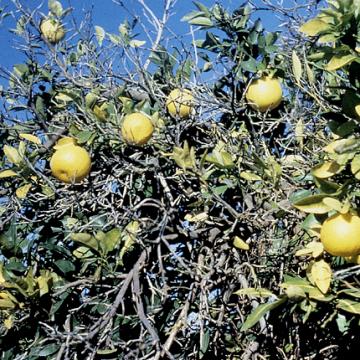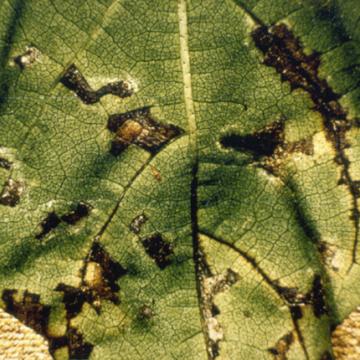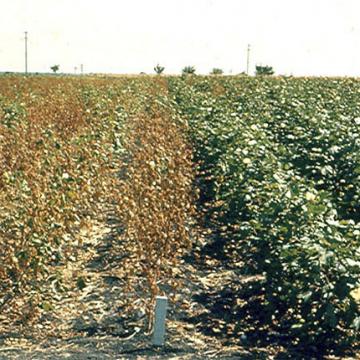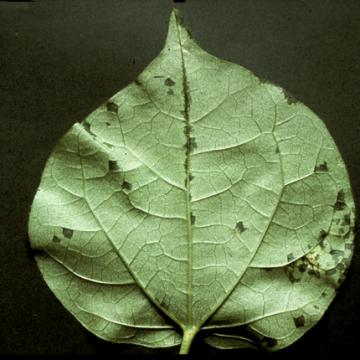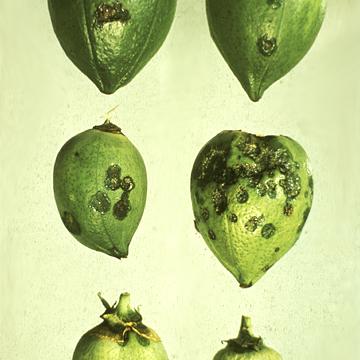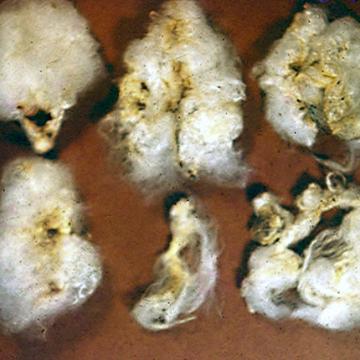DISEASE: Australian citrus dieback
HOST: Citrus (Lime)
Severe decline, a late stage of disease. The disease spreads slowly in mature trees, progressing faster in young trees.
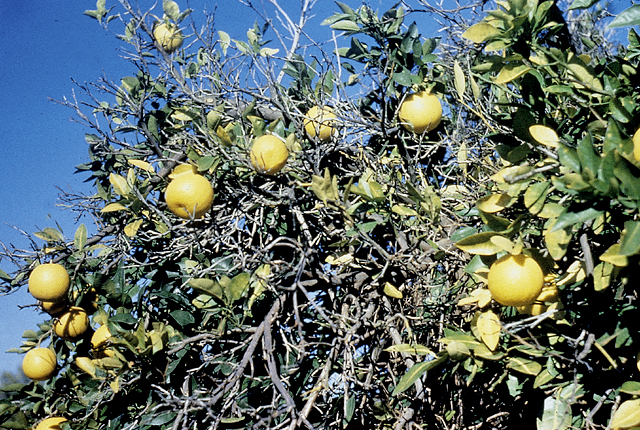
Australian citrus dieback | Citrus (Lime)
DISEASE: Australian citrus dieback
HOST: Citrus (Lime) (Citrus sp.)
PATHOGEN: 'Candidatus Phytoplasma australiense'
PATHOGEN SYNONYM: Phytoplasma Stolbur group
SOURCE: P. Broadbent
DISEASE: Bacterial blast and black pit
HOST: Citrus (Lime)
Characteristic symptoms of brownish black lesions on twigs and leaves (blast), starting with infection of petioles. Black pit refers to brown to black sunken spots on fruit, 5 to 20 mm in diameter.
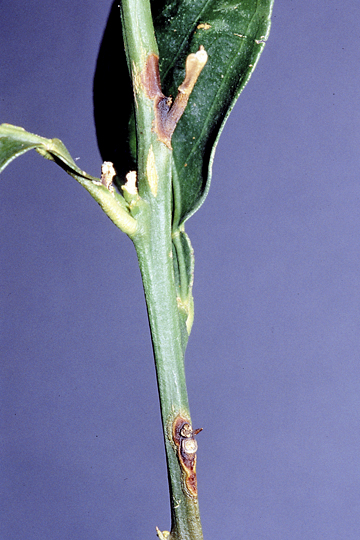
Bacterial blast and black pit | Citrus (Lime)
DISEASE: Bacterial blast and black pit
HOST: Citrus (Lime) (Citrus sp.)
PATHOGEN: Pseudomonas syringae pv. syringae
SOURCE: P. Broadbent
DISEASE: Bacterial blight (Angular leaf spot)
HOST: Cotton
Leaf with advanced stage of blight.
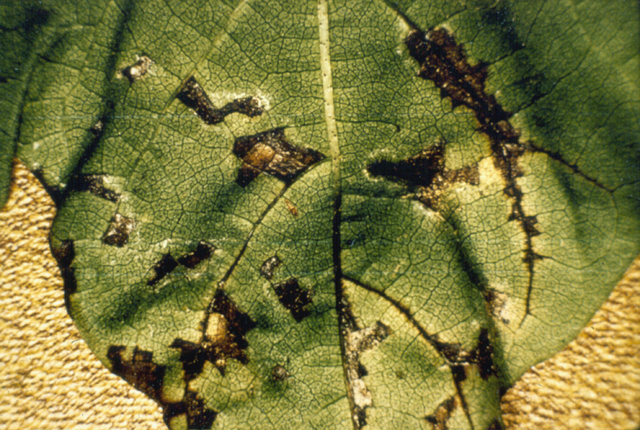
Bacterial blight (Angular leaf spot) | Cotton
DISEASE: Bacterial blight (Angular leaf spot)
HOST: Cotton (Gossypium barbadense)
PATHOGEN: Xanthomonas citri subsp. malvacearum
PATHOGEN SYNONYM: Xanthomonas campestris pv. malvacearum
SOURCE: M. Shurtleff
DISEASE: Bacterial blight (Angular leaf spot)
HOST: Cotton
Highly susceptible (left) and resistant (right) cotton cultivars. The black arm stage of the disease is the most serious and occurs when bacteria invade petioles and then stems.

Bacterial blight (Angular leaf spot) | Cotton
DISEASE: Bacterial blight (Angular leaf spot)
HOST: Cotton (Gossypium barbadense)
PATHOGEN: Xanthomonas citri subsp. malvacearum
PATHOGEN SYNONYM: Xanthomonas campestris pv. malvacearum
SOURCE: APS
DISEASE: Bacterial blight (Angular leaf spot)
HOST: Cotton
Characteristic early symptoms are water-soaked leaf spots and water-soaking along veins.
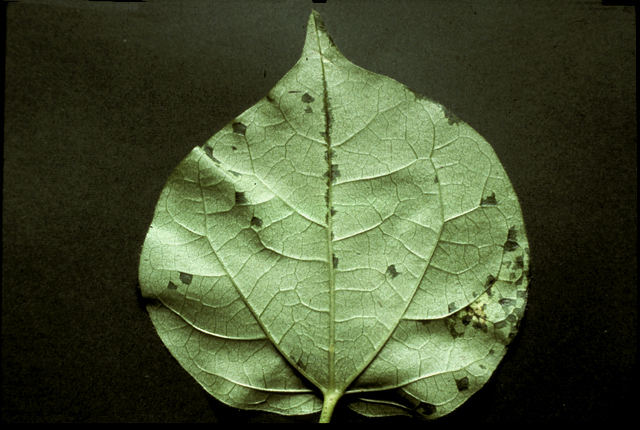
Bacterial blight (Angular leaf spot) | Cotton
DISEASE: Bacterial blight (Angular leaf spot)
HOST: Cotton (Gossypium barbadense)
PATHOGEN: Xanthomonas citri subsp. malvacearum
PATHOGEN SYNONYM: Xanthomonas campestris pv. malvacearum
SOURCE: A. Hayward
DISEASE: Bacterial blight (Angular leaf spot)
HOST: Cotton
Leaf with dark, angular leaf spots. Systemic invasion causes blackening of midribs.
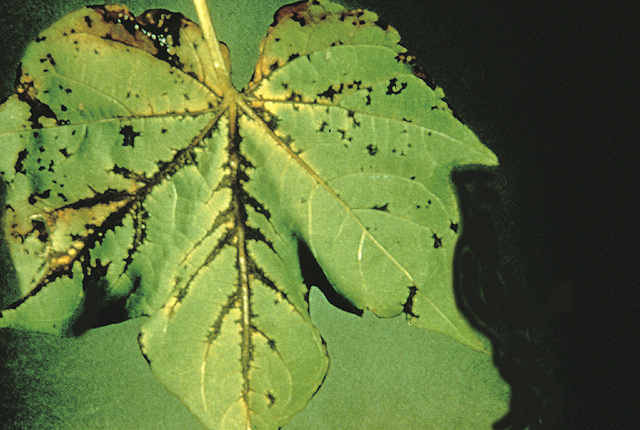
Bacterial blight (Angular leaf spot) | Cotton
DISEASE: Bacterial blight (Angular leaf spot)
HOST: Cotton (Gossypium barbadense)
PATHOGEN: Xanthomonas citri subsp. malvacearum
PATHOGEN SYNONYM: Xanthomonas campestris pv. malvacearum
SOURCE: APS
DISEASE: Bacterial blight (Boll rot)
HOST: Cotton
Boll rot first appears as raised, water-soaked lesions, which become sunken and turn brown to black with time.
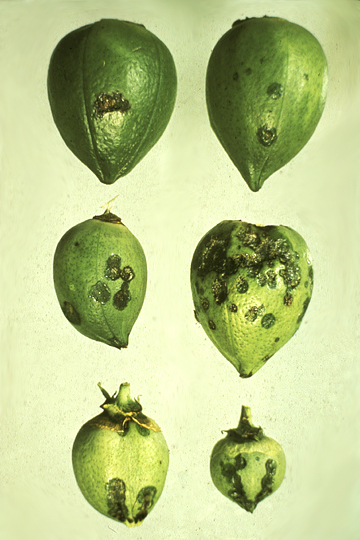
Bacterial blight (Boll rot) | Cotton
DISEASE: Bacterial blight (Boll rot)
HOST: Cotton (Gossypium barbadense)
PATHOGEN: Xanthomonas citri subsp. malvacearum
PATHOGEN SYNONYM: Xanthomonas campestris pv. malvacearum
SOURCE: A. Hayward
DISEASE: Bacterial blight (Boll rot)
HOST: Cotton
Infection of bolls causes premature opening and increased susceptibility to secondary, saprophytic microorganisms that cause rot. Note discolored cotton.
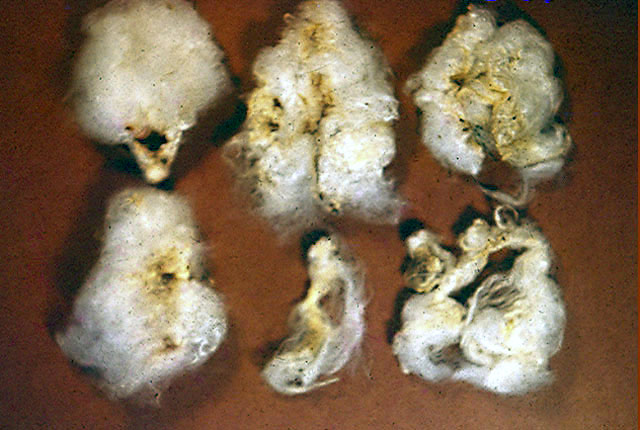
Bacterial blight (Boll rot) | Cotton
DISEASE: Bacterial blight (Boll rot)
HOST: Cotton (Gossypium barbadense)
PATHOGEN: Xanthomonas citri subsp. malvacearum
PATHOGEN SYNONYM: Xanthomonas campestris pv. malvacearum
SOURCE: APS
DISEASE: Bacterial leaf spot
HOST: Cowpea
Leaf spots vary in size from small to large and some fall out in time, leaving a shot-hole appearance.
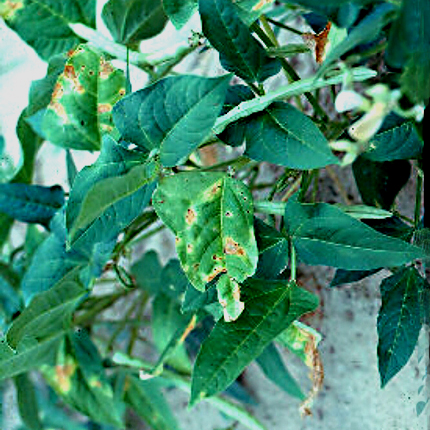
Bacterial leaf spot | Cowpea
DISEASE: Bacterial leaf spot
HOST: Cowpea (Vigna unguiculata)
PATHOGEN: Xanthomonas axonopodis pv. vignicola
PATHOGEN SYNONYM: Xanthomonas campestris pv. vignicola
SOURCE: R. Gitaitis


